#planetenfreund
Text
This Landscaping Company is Rescuing Atlanta’s Urban Canopy
The city in the forest has a plant problem. More specifically, with non-native plants, whose invasive spread, accelerated by human planting and seed-dropping birds, threatens the biodiversity of Atlanta’s native flora. Taking a walk through most Atlanta neighborhoods, one can quickly spot numerous invasive plant species. In my own area of West Midtown, the evergreen leaves of Chinese privet and Japanese honeysuckle pervade back yards and local parks. The rope-like vines of English Ivy crawl up the trunks of our neighborhood’s oldest trees and Chinese wisteria hangs from suspended powerlines along the highway. Even in manicured lawns and gardens, non-native monkey grass with its stalky purple flowers grows in thick, lush rows.

In the absence of natural predators and competitive species, foreign plants can grow rampant in new environments. With their advantages over native greenery, invasive species easily wins the race for territory, sunlight, and other vital resources. The uninhibited spread of invasive species stifles the growth of young trees, blankets forest floors, and can even cause mature trees to fall and uproot. When uncontrolled, areas impacted by invasive plants become unable to sustain native plant growth. These areas can be rapidly overrun by monocultures, like the vast acres blanketed in kudzu one can see driving down any given highway.
Looking at the numbers, Tanya Povolny saw an opportunity to aid Atlanta’s urban forest: The majority of the city’s trees are privately owned, with estimates that 80% or more of the total canopy is on residential properties. Targeting invasive vegetation on privately-owned land could rescue thousands of acres of Atlanta trees. In October 2019, Povolny founded EcoLogic, a company specializing in restoring native landscapes. EcoLogic offers a wide variety of native plant care and invasive species removal services, all without the use of herbicides. I recently spoke with Povolny to learn more about her new venture and her journey in conservation work.

At EcoLogic, Povolny and her team of three restoration technicians use a low-impact, manual approach to revitalize forested Atlanta properties. Since the company does not use weedkillers such as glyphosate, which has been linked to cancer and harms native flora and fauna, all of their labor must be done by hand. “We only work in five-hour shifts,” Povolny explains. “It’s heavy work. It’s hard on your body. Doing more than that is not viable or sustainable.”
Knowledge of native species is critical for leaving the landscape unharmed. “The main thing is knowing what to take out and what to leave behind. It’s vitally important to the forest’s ability to bounce back,” Povolny says. “Untrained landscaping crews, when they come in to do ivy removal, they’re taking out everything.” This presents a threat to some rare native species that resemble invasive ones. Like the bay star-vine, which grows in the Fernbank Forest. “If you don’t know better, you would think that it looks like English Ivy,” she tells me.
Founding EcoLogic is the latest endeavor in Povolny’s storied experience in environmentalist work. “One of the main themes of my life has always been nature and being outdoors and being connected to the Earth,” she divulges. “I knew I was going to be unhappy having to do a desk job where I was forced to stay indoors all the time. I was really looking for something after undergrad that would allow me to bring together all of these interests in a venue that also allowed me to connect with nature.”

Povolny joined Americorps, where she worked with children in agricultural and environmental education programs. She then began taking ecological classes at Austin Community College while also overseeing a chicken coop program for a local 4H chapter. Eventually, Povolny enrolled grad school, studying landscape architecture at the University of Texas in Austin. She continued for two years in the program before deciding to drop out: “It was so geared towards the business side of landscape architecture [rather than] how to affect change in our environment and bringing together mental health [with] nature and how we use our built environments to speak to our intentions,” she explains. “Funnily enough, now that I’m a business owner, I appreciate some of the things I was learning. But at the time . . . I felt very disconnected from what it was that I wanted to be getting out of it.”
After leaving grad school, Povolny relocated to Atlanta and took up work with the Deep Forest Field School, a restoration nonprofit group operating in the Fernbank Forest. During that time, she assisted on founder Dr. Jeremy Dahl’s environmental research team. Eventually, Povolny felt called to start her own restoration company that could offer educational programming. “It was something that I was trying to do for a long time with [Dahl], but we never really got it off the ground,” she shares. “So that’s one of the reasons that I felt that I needed to start my own thing, to broaden those opportunities, because they just weren’t being exploited.”

Currently, Povolny’s technician crew consists of three artists whom she befriended in the local DIY scene. “It’s funny who you find doing this kind of work,” she says. “I had these friends through [the DIY community] and they were approaching me about being interested in this kind of work.” Povolny has been training her team for nearly two months now, sharing the expertise she has acquired through her years of experience.
While formal education is beneficial for restoration work, Povolny finds it is not mandatory: “You don’t need an informed educational background. It definitely helps, and I find that it makes people more interested.” As she sees it, a concern for the environment can be more valuable than one’s experience level. “It requires you to be aware, to pay attention, to put it bluntly, to give a f--- about the end result,” she explains. “That’s really what you have to start with. If you have that, you can learn everything you need to know about forest restoration within a year.”

As for the most challenging aspect of Povolny’s work at EcoLogic: “Getting the word out there. Reaching people. That’s the hardest thing . . . I think that’s probably difficult for any new business, especially if you don’t have a budget, which I don’t,” she says and laughs. Currently, the business remains focused on invasive species removal as it continues to grow. Povolny already has her eyes set on expanding, however: Eventually, she envisions EcoLogic branching out to include community outreach and educational programming. “That’s really the direction I am most interested in,” she explains.
In the meantime, the hard work continues; on EcoLogic’s Instagram account, the crew can be seen laboring over thickets of privet and tangles of English ivy. In between serious posts educating on sustainable forest management, there is also a smattering of memes about native Georgia flora and fauna. Those interested can also visit the company’s website or follow them on Facebook to learn more.
(Restoration photos courtesy of EcoLogic.)
45 notes
·
View notes
Text
Volunteer Tree Planting with Trees Atlanta

Over the past few years, the state of Georgia has made headlines for leading the nation in urban tree loss. I decided to take action this week by volunteering with Trees Atlanta, an organization dedicated to protecting the city’s tree canopy, to plant some trees in local neighborhoods.
After a post-recession recovery, thousands of new residents have flocked to the city of Atlanta. In fact, the city recently saw the third-highest population growth in the nation. For the metro area, this means more new developments and an increase in felled trees, to the tune of 18,000 acres on average annually. This comes at a high price for Atlanta: Among other costs, tree loss means hotter summers, lower water quality, increased ozone production, and a blow to its identity as the “City in the Forest.”
In terms of their physical attributes, trees give back to the planet in many ways. You likely have heard about how trees provide oxygen for us to breathe, filter pollutants out of the air, and are crucial in managing atmospheric CO2 levels. However, trees have several additional valuable qualities that are less commonly known. Trees block wind and provide heat insulation in the winter, and during the warmer months, forested areas are up to 10 degrees cooler than neighboring areas with no tree canopy. Planting trees, therefore, saves energy by reducing the need for electric heating and air conditioning. Trees also reduce noise pollution, prevent soil runoff and water pollution, and encourage biodiversity.
Did you know that several studies have shown that communities with a greater tree canopy have lower crime rates? Similarly, researchers have found trees to provide numerous health benefits: The presence of trees can aid in mitigating stress and reducing the risk of cardiometabolic diseases. Studies even demonstrate that hospital patients recovering from surgery require less medication and recover quicker when placed in rooms with a view of trees.
Founded in 1985, Trees Atlanta is a nationally-recognized nonprofit organization dedicated to the preservation of Atlanta’s tree canopy. Fueled by volunteer work and offering a wide variety of community programs, the nonprofit describes itself as a “citizens’ group that protects and improves Atlanta’s urban forest by planting, conserving, and educating.” I was excited to get involved with this group to help restore my city’s urban forest.

To volunteer, I first registered for a planting shift on the Trees Atlanta website. On the day of my shift, I drove to their Operations Center just three miles southwest of downtown Atlanta, where I was greeted by coordinator Matt Dort. Matt started planting with Trees Atlanta seven years ago as a volunteer and now leads the organization’s neighborhood planting program. I also met Keithan, a fellow first-time planter. Keithan explained that he chose to volunteer with Trees Atlanta out of concern for the environment.

From the Operations Center, Matt drove us to our first planting site, a nearby neighborhood along the downtown connector. Our first mission: to replace a damaged young Eastern redbud with a healthy sapling of the same species. The damaged tree would later be salvaged and rehabilitated at the Operations Center. Matt explained that redbuds are a common species on the Piedmont Plateau and are particularly well-suited for residential neighborhoods. We grabbed our shovels and took to digging. Pulling up the roots turned out to be more of a challenge than we had anticipated; with three people, this transplant ended up taking close to an hour.


After laying the mulch on our first tree, we hopped back into the truck and drove to our second site: Waterworks Park. This newly redeveloped greenspace was opened just a year ago in my own neighborhood of West Midtown. I was happy to help expand the tree canopy in my local community.
Once again, our work was not easy. We found that the park was sitting atop layers of gravel and tough Georgia clay. To dig the holes for planting new trees, we had to break up these hard layers with a pickaxe before shoveling away heavy piles of rock. Matt explained that the terrain would not be an issue for the trees, however, as only particularly durable tree species were selected for this tough urban environment.

We planted two additional saplings in the park that afternoon: an elm and a bald cypress. By the end of the shift, we were each covered in our fair share of mud and dirt. It definitely felt like an afternoon well spent.
Planting with Trees Atlanta was a thoroughly fulfilling experience and I highly encourage anyone who is interested to get involved. In addition to offering diverse volunteer opportunities every week, Trees Atlanta also hosts regular educational and community events. To learn more about upcoming opportunities and register for a volunteer shift, check out their official calendar.
#planetenliebe#planetenfreund#treesatlanta#climate activism#sustainability#atlanta#trees#volunteering#fridaysforfuture
4 notes
·
View notes
Text
Food waste burdens the Earth’s atmosphere. The solution is easy.

Some might find this plastic bucket unsightly, but to me, it is an essential piece of my journey to live more sustainably.
In landfills, rotting food waste is the leading producer of methane, a greenhouse gas that can trap 30 times more heat in the atmosphere than carbon dioxide. Composting what we can from our kitchens is one simple way to divert waste from dumps and repurpose it.

Last week, I started composting my kitchen scraps with the help of this bucket I got secondhand. When the lid is closed, it is virtually airtight and gives off no odors. When full, I plan to drop off my pile with one of the numerous community gardens around Atlanta that accept compost material such as the Wylde Center.
Here are some items that you can put right into your household compost bucket:
Used coffee filters.
Eggshells.
Raw fruit and veggie scraps.
Napkins from water or juice cleanup (no oils).
Yard trimmings.
Unless you pay for industrial composting, cooked food, as well as meat and dairy, are not compost-friendly. It's therefore important to remember to buy and cook only as much food as you plan to eat and eat your leftovers before they go bad!
If you don’t have one already, starting your own compost pile costs nothing and is one more way you can be a friend of the planet. 🌎
#planetenfreund#planetenliebe#biomüll#composting#compost#landfill diversion#lowwaste#noWaste#greenatlanta#atlanta#wylde center#methane#greenhouse gas#climate change#sustainability#sustainable#nachhaltigkeit#nachhaltig
3 notes
·
View notes
Text
Boycotting Black Friday: An Environmental Day of Action
“What do you want for Christmas?”
In the days leading up to Thanksgiving this year, I began to hear this familiar question from my family. (Sadly, “a plastic-free ocean” wouldn’t fit on my wish list.) Like millions of Americans, my relatives were looking to snag some deals over the Black Friday weekend. Though I will also be wrapping some presents for family this year, I decided to skip shopping in the days following Thanksgiving, opting instead to get outdoors and clean up a local park.
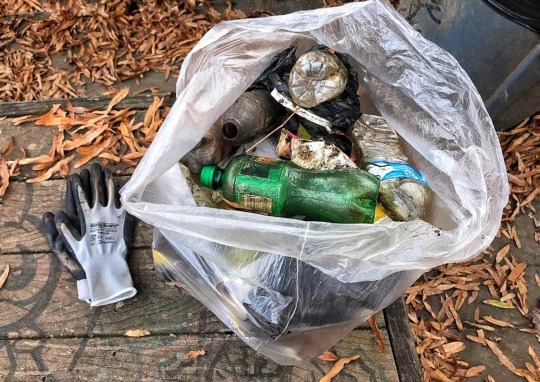
As Black Friday discounts spread around the globe and American shoppers are spending more on this day every year, the environmental impact of our purchasing habits is adding up.
The online and in-store shopping spike between Black Friday and Cyber Monday means more delivery trucks on roads and freight ships crossing oceans. This creates a worldwide surge in air pollution concentrated over just a few days. Our discounted goods have companions, too: packing peanuts, plastic shopping bags, and other packaging pile up on this shopping holiday, and are all but doomed for the landfill. The heavily-discounted items we buy over this weekend, such as new technology and clothing, are no different. Globally, 50 million tons of electronics waste is produced annually, and Americans are throwing away clothes at a rate of 13 million tons per year.
Some organizations have begun a push to boycott Black Friday.
The international environmentalist group Greenpeace endorses Buy Nothing Day, a sort of anti-holiday that originated in Australia in 1997. Participants observe the day, which commonly takes place on or around Black Friday, by abstaining from making any purchases for 24 hours.
REI, the outdoor recreation company, promotes a similar approach. Starting in 2015, REI began closing its stores (and shutting down its website) on Black Friday, encouraging employees and customers to instead spend the day outdoors. The company created the social media hashtag #OptOutside to promote the initiative, which this year became part of a larger climate action campaign. Starting with the coordination of over 100 litter cleanup events around Black Friday, REI marked November 2019 as the kickoff of its “Opt to Act Plan.” This free-to-use plan provides participants with 52 simple weekly challenges intended to reduce one’s environmental impact.
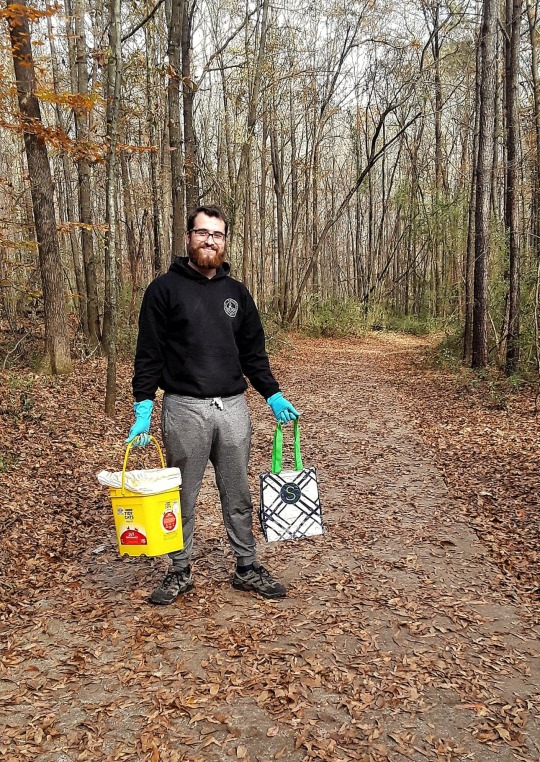
The day after Thanksgiving, I recruited my friend Marcus McCleary to join me in cleaning up Constitution Lakes, a nature preserve tucked behind a truck dealership off a busy industrial boulevard in Southeast Atlanta.

(Street view courtesy of Google Maps)
Visitors to this unique park may take the boardwalks over two small, minnow-filled lakes and can also stroll along the Doll’s Head Trail, a short hiking loop featuring folk art sculptures made of found objects scattered throughout the park. Marcus is a regular contributor to these sculptures himself.
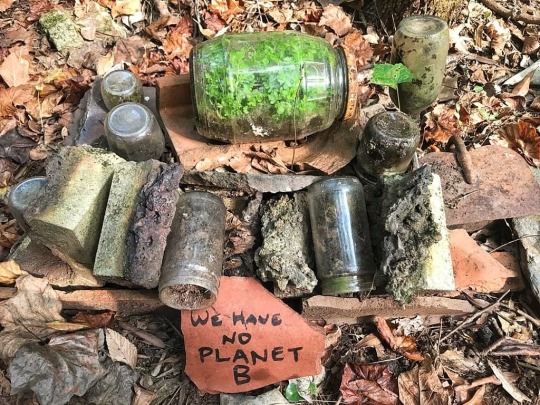

We set out with our gloves and bags, often having to tread through twigs and briars to pick up litter off the sides of the walking paths. Among our discoveries were plenty of weathered beer cans and heavily-soiled soda bottles, some even with moss growing inside them. Along the banks of the lakes, we found lots of styrofoam cups and plastic wraps, some too far out in the water for us to reach.
I have written about the consequences of littering before, but I was reminded of an additional one during this cleanup: Tossing trash in nature can ruin perfectly good recyclables. Our first bag of litter included numerous bottles that were simply too filthy to clean for recycling.
In addition to the usual offenders (food wrappers, tobacco products, etc.), here are some of the more unique items we found during our cleanup:
A dilapidated bouncy ball.
A box of condoms.
Tangles of fishing wire.
A THC cartridge.
Underwear hung from trees.
A glass Coca-Cola bottle from 1979.
An antique iron doorknob (Marcus added this to a Doll’s Head sculpture).
Several of the objects Marcus and I found had obviously been discarded decades in the past. This made me think about how long items littered today will lay in waiting before someone comes along to clean them up.
Here is the final haul of litter we carried out of the park, not including the first bag we tossed halfway through:
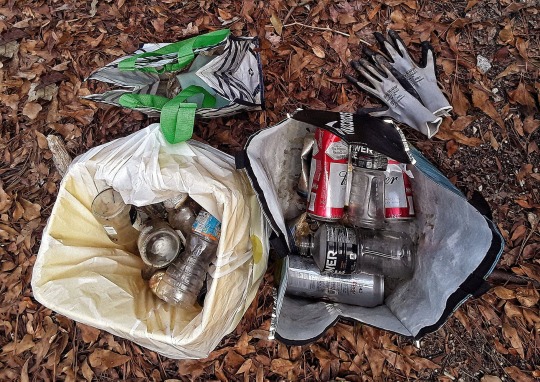
We ended up collecting a respectable pile of bottles and cans for recycling:
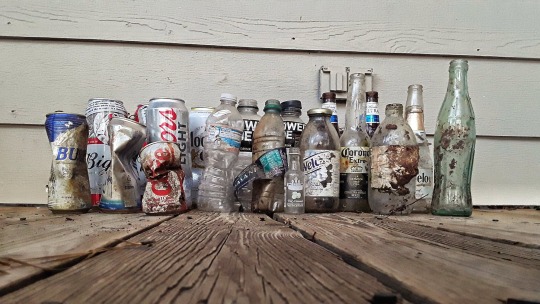
I am glad to have spent my Black Friday cleaning up outside instead of cleaning out a sales rack. This project also let me check off Week One of the 52-week Opt to Act Plan: To make cleaning up a daily habit. I encourage anyone reading this post to check out the plan for yourself and see how you can take small steps to be a friend to the planet. 🌎
#buy nothing day#black friday#outoutside#opt to act#rei#litter#atlanta#planetenfreund#planetenliebe#recycle#nowaste#environmentalist#climate activism#cyber monday
3 notes
·
View notes
Text
Planetenfreund — A Friend of the Planet
Hi internet! My name is Jo, and I’m an aspiring environmental advocate and German teacher. Here’s me at the Dogwood Festival in my hometown of Atlanta, Georgia:

(Fun Fact: Atlanta is known as “The City in the Forest” because of its vast tree canopy.)
I am a trained German language teacher with an MA in German Literature. Spending time in Germany and studying the German culture gave me some valuable insights into what environmental sustainability looks like in other countries. I took these lessons home with me to Georgia, where I constantly see opportunities to prevent waste and reduce environmental impact.
This blog is intended to document my thoughts on sustainable living and my journey as I attempt to practice environmentally-responsible habits. I look forward to exchanging with other friends of the planet!
#planetenfreund#first post#environmentalist#about me#german#germany#sustainability#environmentalism#earth#zerowaste#recycling
2 notes
·
View notes